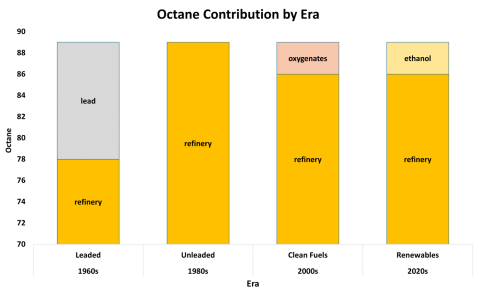Oxygen-containing gasoline additives called oxygenates, including ethanol, have provided an octane boost to the U.S. gasoline pool since 2000. This has allowed refineries to reduce the octane of refinery-produced gasoline, which increases their gasoline production capacity and efficiency while simultaneously helping achieve the goals for cleaner, lower-carbon fuels derived from domestic renewable feedstocks. A new approach to gasoline formulation promises to take this “sharing” of the octane load much further to exploit the unique octane-enhancing qualities of ethanol, although there are some real-world challenges to wider implementation. In today’s RBN blog, we explain what’s behind the concept of “hydrogen-rich” gasoline.
In the first blog in this series, I Love a PIANO, we explained that two types of petroleum molecules (olefins and aromatics) are high in octane and two other types (naphthenes and paraffins) are low in octane, while a fifth (isoparaffins) can vary from moderate to very high octane. (That’s all the chemistry you need to know to understand the basics of gasoline octane.) These five molecular types — paraffins, isoparaffins, aromatics, naphthenes and olefins — form the acronym PIANO, which is the common name of the hydrocarbon-type analysis used by refiners and gasoline blenders.
As explained in our Breaking the Chains series, octane is a measure of a gasoline’s resistance to pre-ignition during compression in an engine cylinder, which can cause a knocking sound. It is also the primary yardstick of gasoline quality and price. The numbers you see on service station gasoline pumps are the octane ratings of the products — typically 87 for regular gasoline and 93 for premium. The PIANO analysis tells gasoline producers how much of each hydrocarbon type are in each gasoline blendstock, which helps blenders apply the basic strategy of gasoline octane production, which is to get enough of the O’s (olefins) and A’s (aromatics) into each product to meet its octane specification.
Figure 1. The Four Eras of Octane Technology. Sources: Hoekstra Trading LLC, RBN Energy
Join Backstage Pass to Read Full Article









